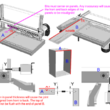Automatic Mating
 The foolproof and auto mate images are all heavily modified versions of the one I took from a Maggi manual (pg 24 110KB pdf). The basic concept of auto mating is that the Y end-bore distance from the drill bits to the A panel face equals the Y face bore distance from the drill bits to the end of panel B (image bottom). The theory is that all holes will be an equal distance from the face of panel A and the end of panel B. The first problem is that any variation in panel thickness changes the Y end bore distance. The end-bored holes holes will be closer to, or further away from, the face of the A panel. Any variation in panel thickness translates to an equal variation in joint alignment, the A face will be above or below the end of the B panel.
The foolproof and auto mate images are all heavily modified versions of the one I took from a Maggi manual (pg 24 110KB pdf). The basic concept of auto mating is that the Y end-bore distance from the drill bits to the A panel face equals the Y face bore distance from the drill bits to the end of panel B (image bottom). The theory is that all holes will be an equal distance from the face of panel A and the end of panel B. The first problem is that any variation in panel thickness changes the Y end bore distance. The end-bored holes holes will be closer to, or further away from, the face of the A panel. Any variation in panel thickness translates to an equal variation in joint alignment, the A face will be above or below the end of the B panel.
How much the joint is off depends on the consistency of the material being used. How much it matters depends on the accuracy desired. A joint that is .10mm/.004" off is visibly out of alignment and even a .05mm/.002" difference can be felt. Even the most consistent material is not that consistent. Using a digital caliper I took a bunch of measurements from two sheets of melamine coated particleboard. The thickness of each sheet varied by .24mm/.01" and the maximum variation between the two sheets was .39mm/.015". Maybe that's OK, if that is the amount that the A panel face sits below the end of the B panel. The problem is that it is not easy to control where those inconsistencies show up.
When using a panel to set the face boring fence (auto mate method), there is no assurance (without taking a lot of measurements) that the panel used to set the fence is consistent in thickness from end to end, or if its thickness is representative of the batch. That alone insures inaccuracy, but it's also a manual setting that's prone to human error. Maybe there's a slight bow in the material and the fence was rocked to one side when it was tightened it down. Using this method, the fence will never be perfectly parallel to the drill head and any deviation will be mirrored in the joint.
While using gauge blocks to set the face boring fence will be more accurate, how thick should the gauge blocks be? To insure that the face of panel A is never above the end of panel B, the gauge blocks need to be no thicker than the thinnest part of the thinnest piece that will be end-bored. The bottom line is that the bored outside-face-up A panel will not line up consistently with the end of panel B.
The second issue with end-boring panel A outside-face-up is the front to back joint alignment, how flush the front and back edges of panel A and B will be. The problem with boring both panels face up is that there is no common reference point. One panel is bored with its front edge against the fence and the other is bored with its back edge against the fence. The location of the side fence is critical in determining how well the joint aligns. A drill bit, or the center-point between two drill bits, has to be dead center on the panels for the front and back of the panels to be flush.
Unlike 1:1 panel thickness/joint variations, any off center deviation doubles the joint offset. Holes that are .125mm closer to the front edge of panel A will be .125mm further away from the front edge of panel B. The result is that the front and back edges of the panels will be offset by .25mm (2:1). Unless every panel that will be bored is an exact increment of 32mm, the side fence location will need to be adjusted. Like face bore fence setups need to be adjusted to account for slight variations in material thickness, end-bore fences need to be adjusted to account for even slighter variations in panel width.
I have no idea why auto mating is presented as it is, using two fences makes front to back joint alignment a lot easier. While it requires that the side fences be exactly the same distance from a drill bit, any deviation is simple math (combined deviation equals joint deviation), all panels can be drilled with their front (or back) edges against a side fence (semi common reference point) and panel widths don't have to be in precise 32mm increments. Unlike the end bore fence, which needs to be adjusted to accommodate various panel thicknesses, face-bore side fences can be set once to accommodate all panel widths.
A much better alternative is Foolproof Mating where joint alignment is unaffected by either material thickness or side fence location.
![]()
